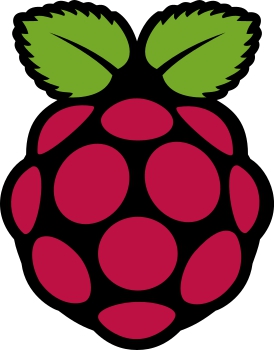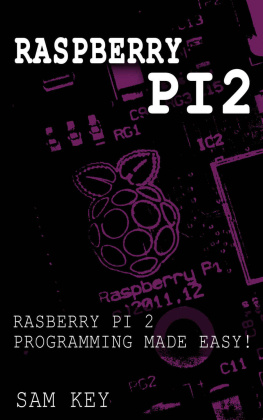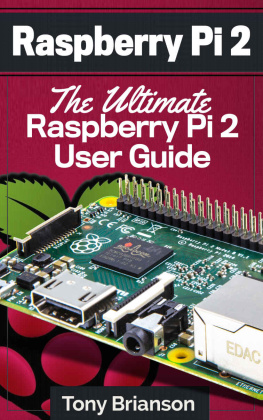Raspberry Pi 4 For Everyone
An Advanced Guide for Starters, Intermediates, and Experts to Become A Pro on Raspberry Pi 4
By
David Crux
Copyright 2020 David Crux
All Rights Reserved
Table of Contents
Chapter One
Introduction
W hen you hear the word Raspberry Pi 4, what comes to mind may be a fruit, especially for those who are not conversant with what it is. They might think, oh wow it is something edible and because it sounds like some fruit in the class of strawberry. It wouldn't be a surprise if one would think like that after hearing the word raspberry, it is like a sixth sense or something.
Now, this is different for tech guys, those who are more inclined to things that concern technology. These just get the information when the word Raspberry Pi 4 is mentioned, they easily understand what has been said and you might be surprised at how much they know. Now the word might be confusing to those who aren't techy, so if there was a debate about what it is, we might have a war as most people might argue strongly from their point of view about it being a fruit or something understandable, come to think of it, who names a software after food.
Now to avoid arguments that may occur as raspberry being a fruit and not, this book will shed more light on what raspberry pi4 is to those who do not grasp the idea of what it is, so they have an understanding of what it is. To those who are familiar with it but do not know how to use it or go about it, this book will be a guide on how to use the raspberry pi 4 and help clarify a lot of confusion, so it is more like a how-to book.
To fully grasp what Raspberry Pi 4 is about, we would have to start from somewhere, the basics. We would have a look at what Raspberry Pi is, how it began, and how it works. This is the first step to understanding what it is. We would also take a look at a whole lot of things and trust it to be fun. Sit back, relax as you not only enjoy but also buy, learn, and add more information to your knowledge bank. Now before we go into all of what raspberry pi is let us take a peek at what it is and where the use of raspberry started.
The first attitude to learning is showing interest in whatever it is one has resolved in his or her heart to learn right. It is not enough to say you want to learn about something and not show it, you might get the teacher confused. On the other hand, to know that you are interested in something is in the questions you ask, you want to know the "what, How, when, why, and where" These are questions that spark up curiosity which leads to research and yields results.
What is Raspberry Pi?
Starting with the "what" Raspberry Pi is a low-cost computer that looks like the size of a credit card, which is plugged into the computer monitor or television and uses a standard keyboard and mouse. It is a little device that is capable of enabling people of all ages to explore computing, and also learn how to program in languages such as scratch and python.
image1
The raspberry pi launched in 2012 and there have been several versions released since then. The original pi had a single-core 700 MHz CPU and just 256MB RAM, and the latest model has a quad-core 1,4GHz CPU with 1GB RAM. Now the main price for Raspberry Pi has always been $35 or less including the Pi Zero which costs $5.
All over the world, the use of Raspberry Pi is versatile, it is used to learn programming skills, build hardware projects, do home automation, and even use them in industrial applications. The Raspberry Pi is a very cheap computer that runs Linux but also provides a set of GPIO ( general purpose input/output) pins that allow you to control electronic components for physical computing and explore the internet of things(IoT). Now let's take a look at where it all began, shall we?
History
It has been said that if you want to lead a better future, you will have to go back to the past, see how it started that way you would be able to figure out the future. Now we are going to be taking a look at where the use of raspberry pi began, you know what they say; you can never go wrong with history.
The first thing you might want to know is that Raspberry Pi is the name of a series of small single-board computers made by the United Kingdom by the raspberry pi foundation in association with Broadcom. Now early on the raspberry pi project moved towards the promoting of teaching basic computer science in schools and developing countries and later the original model became far more popular than expected, selling outside its target market for uses such as robotics, Now it is widely used in diverse areas such as weather monitoring, this is because of its low cost, modularity, and open design.
In 2006, early concepts of the Raspberry Pi were founded on the Atmel ATmega644 microcontroller. Its schematics and PCB layout are publicly available. Now Foundation trustee Eben Upton gathered together a group of teachers and academics and computer enthusiasts to devise a computer to inspire children. The computer is inspired by Acorn''s BBC Micro of 1981. The Model A, and Model B and Model B+ names refer to the original models of the British Educational BBC Microcomputer developed by Acorn Computers. the ARM version of the computer was the prototype that was mounted in a package the same size as a USB memory stick, it had a USB port on one end and an HDMI port on the other end.
Now the foundation's goal was to offer two versions, which were priced at US$25 and $35, They began to accept orders for the higher-priced Model A in February 2012, the lower-cost Model A and February 2013, and the lower cost at $20 A+ on November 10, 2014. On November 26, 2015, the cheapest Raspberry Pi yet, the Ras[berry Pi zero was launched at $5. Now according to Upton, the Raspberry Pi was chosen with Raspberry as an ode to a tradition of naming early computer companies after fruit and Pi as a reference to the python programming language.
When the second board type was released the raspberry pi foundation set up a new entity which was named raspberry pi trading, and also installed Eben Upton as CEO, with the responsibility of developing technology. The foundation was then rededicated to as an educational charity for promoting the teaching of basic computer science in schools and countries that are being developed.
You might want to know that the Raspberry Pi is the bestselling, if not one of the best-selling British computers. More than 30 million boards have been sold as of December 2019. Most Pis are made in a Sony factory In Pencoed, Wales, and the others are made in China and Japan.
Let us take a look at some of the generations of Raspberry Pi that have been released before now. The models feature a Broadcom system on a chip(SoC) with an integrated ARM compatible central processing unit(GPU). However, the first generation (Raspberry Pi Model B) was released in the year 2012 as mentioned before in February, which was followed by the simpler and cheaper Model A.
Then in 2014, the foundation released a board with a revamped design, Raspberry Pi Model B+. Now, these first-generation boards feature the ARM11 processors, they are approximately credit-card sized and represent the standard mainline form factor. Revamped A+ and B+ models were released a year later. A computer module was released in April 2014 for the applications that had already been embedded.
We now look at the Raspberry Pi 2 which was released in February 2015 and featured a 900 MHz 32-bit quad-core ARM Cortex-A7 processor with 1 GiB RAM initially, but later versions featured a 1.2GHz 64-bit quad-core ARM Cortex-A53 processor.






